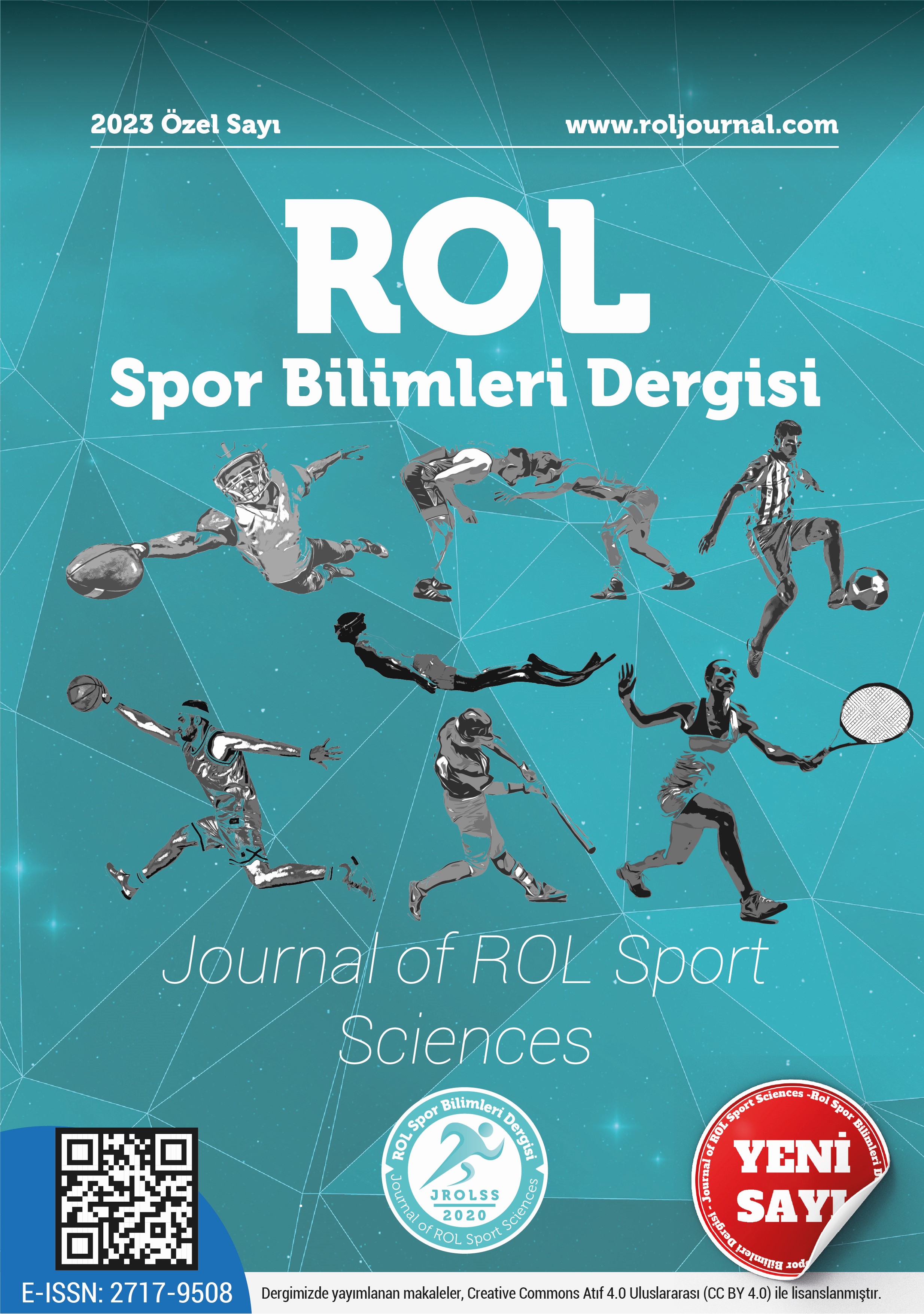Investigation of the effect of fartlek training on aerobic performance in adolescent female basketball players
DOI:
https://doi.org/10.5281/zenodo.10036155Keywords:
Adolescence femal, basketball players, fartlek training, VO2maxAbstract
This study was conducted to determine the effects of fartlek training on running distance and maximal oxygen consumption capacity (VO2 max) in female basketball players. There were 21 participants in the experimental group (N:12, mean age:14.83 years) and control group (N:9, mean age:14.83years). In this practice, a two-group pretest-posttest model was used. In this study, the experimental group performed running exercises using the Fartlek method on hilly terrain for 8 weeks, while the control group performed aerobic training on flat terrain. In addition to measurements of body weight (BW), height, and body mass index (BMI), athletes underwent measurements of the Balke treadmill test and VO2max. SPSS 22 program was used for statistical analysis and G*Power program was used for sample size determination. As a result of the analysis, it was found that 18 participants would be sufficient. It was found that the data given in the study did not show the normal distribution and Wilcoxon signed-ranks test was used in the pre-test and post-test comparison and the Mann Whitney-U test was used in the comparison of the averages of two different groups. As a result of the measurements, it was found that running distance and maximum oxygen consumption capacity (VO2max) in the experimental group were significantly in favour of the posttest, while body weight (BW) and body mass index (BMI) in the control group showed a significant decrease after the posttest compared to pretest values (p<0.005). At the end of the study, it was concluded that fartlek exercises led to a significant increase in running distance and (VO2 max) measurements and had a positive effect on endurance parameters in female basketball players.
References
Aadland, E., Solbraa, A. K., Resaland, G. K., Steene-Johannessen, J., Edvardsen, E., Hansen, B. H., … et al. (2017). Reference values for and cross-validation of time to exhaustion on a modified Balke protocol in Norwegian men and women. Scandinavian Journal of Medicine & Science in Sports, 27(11), 1248-1257. https://doi.org/10.1111/sms.12750
Akyol, P., & İmamoğlu, O. (2019). The effects of a three-month exercise on physical fitness, body composition and some blood parameters in sedentary middle-aged female. Journal of Education and Training Studies, 7(11), 63-71. https://doi.org/10.11114/jets.v7i11.4424
Bompa, T., O. (1999)., Periodisation theory and methodology. IL Human kinetics.
Eleckuvan, M., R. (2014). Effectiveness of fartlek training on maximum oxygen consumption and resting pulse rate. International Journal of Physical Education, Fitness and Sports, 3(1),85-88. https://doi.org/10.26524/14115
George, J. D., Paul, S. L., Hyde, A., Bradshaw, D. I., Vehrs, P. R., Hager, R. L., … et al. (2009). Prediction of maximum oxygen uptake using both exercise and non-exercise data. Measurement in Physical Education and Exercise Science, 13(1), 1-12. https://doi.org/10.1080/10913670802609086
Hazar, K., & Hazar, S. (2016). The effect of continuous running and fartlek training on maximal oxygen consumption capacity. Nigde University Journal of Physical Education and Sport Sciences, 3(10), 351-356
Fahmi, B. S., Omar, A. H., & D. Hamid. (2014). The effects of fartlek training in improving cardiorespiratory fitness among elderly. Malaysian Journal of Movement, Health and Exercise. 8(7),58-63
Feasel, C. D., Sandroff, B. M., & Motl, R. W. (2021). Cardiopulmonary exercise testing using the modified Balke protocol in fully ambulatory people with multiple sclerosis. Cardiopulmonary Physical Therapy Journal, 32(2), 57-65. https://doi.org/10.1097/CPT.0000000000000141
Uslu, S., Hindistan, I. E., & Çetin, E. (2022). Determination of maximum oxygen consumption by machine learning methods using step kinematics. Journal of Sport and Performance Research, 13(2), 201-216. https://doi.org/10.17155/omuspd.1097679
Levine, B., D. (2008). VO2max: what do we know, and what do we still need to know? The Journal of Physiology. 586(1), 25-34. https://doi.org/10.1113/jphysiol.2007.147629
Mitchell, R. D., & Crandall, C. (2017). Validation of the 15-minute Balke field test for competitive, adult 5k runners: From treadmill VO2max testing to enhancing performance. American Journal of Sports Science and Medicine, 5(3), 44-47. https://doi.org/10.12691/ajssm-5-3-1
Nambi, G., Abdelbasset, W. K., Agrawal, S. M., Elsayed, S. H., Verma, A., Vellaiyan, A., … et al. (2022). Comparative effectiveness study of low versus high-intensity aerobic training with resistance training in community-dwelling older men with post-COVID-19 sarcopenia: A randomised controlled trial. Clinical Rehabilitation, 36(1), 59-68. https://doi.org/10.1177/02692155211036956
Sarmidi, S. (2018). Effect of fartlek training on the improvement of VO2max on athlete’s runners of 800-metres. in an international seminar on public health and education, Atlantis Press.
Sutanto, Teguh. (2016). Buku pintar olahraga. Pustaka Baru Press
Stojmenović, D., Trunić, N., & Stojmenović, T. (2022). A comparative study of aerobic capacity among elite basketball players according to five different positions in the team. Journal of Physical Education and Sport, 22(10), 2522-2529. https://doi.org/10.7752/jpes.2022.10320
Fauzan, M. A., Sarifin, S., & Setyagraha, E. (2020). Perbandingan latihan interval dan latihan fartlek terhadap VO2max atlet bola basket fik unm (Doctoral dissertation, Unıversıtas Negerı Makassar). http://eprints.unm.ac.id/19754/
Jadhav, R. (2020). Effect of fartlek training on speed and endurance among athletes. International Journal of Multidisciplinary Educational Research, 9(12), 123-129.
Jones A., M. (2016). Sport and exercise physiology testing guidelines. Routledge.
Vasconcelos, T., Hall, A., & Viana, R. (2017). The influence of inspiratory muscle training on lung function in female basketball players- a randomised controlled trial. Porto Biomedical Journal, 3(2), 86-89 https://doi.org/10.1016/j.pbj.2016.12.003
Vickers, R., R. (2003). Measurement error in maximal oxygen uptake tests. Naval Health Research Centre.
Ziv G., & Lidor R. (2009). Physical attributes, physiological characteristics, on-court performances, and nutritional strategies of female and male basketball players. Sports Medicine, 7(39), 547-68. https://doi.org/ 10.2165/00007256-200939070-00003
Puente, C., Abián-Vicén, J., Salinero, J. J., Lara, B., Areces, F., & Del Coso, J. (2017). Caffeine improves basketball performance in experienced basketball players. Nutrients, 9(9), 1033. https://doi.org/10.3390/nu9091033
Downloads
Published
How to Cite
Issue
Section
License
Copyright (c) 2023 Journal of ROL Sport Sciences

This work is licensed under a Creative Commons Attribution 4.0 International License.

